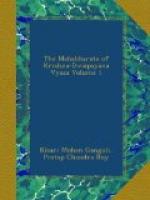Vandin opens the controversy by saying that as the number of each of these is one, so one only intellect is the lord, leader and guide of the senses.
27. There is a Vedic revelation that two birds live together on a tree as friends—one of these eats the fruits and the other looks at the former. From this it is manifest that two are the lords, leaders, and guides of the senses. That there is a second faculty besides the intellect is also proved by the fact that in sleep when the intellect is inactive that faculty continues in action, for if it were not so we could not remember having slept, nor connect the state after awaking with that preceding sleep. Accordingly by citing the number two Ashtavakra assets that besides intellect there is another faculty—consciousness that these two are jointly the lords, leaders and guides of the senses and that they act together as Indra and Agni, etc.
28. By citing the number three Vandin means to say that as it is Acts that produce the three kinds of born beings, etc., so Acts are supreme and that everything else be it intellect alone, or intellect and consciousness together is subservient to Acts.
29. Ashtavakra here advances the thesis that even if Acts be supreme still when the (fourth) or Supreme Being becomes manifest to the soul, it stands in no further needs to Acts.
30. By bringing in the quinquennial series, Vandin wishes to assert that the five senses are competent to cognise their respective objects and that besides these senses and their objects there is neither any other sense to perceive nor any other object of perception. He also cites the authority of the Veda according to which the Apsaras (or consciousness) have five “locks” on their hands—i.e., five objects of perception.
31. Besides the five senses Ashtavakra contends for an additional sense namely the Mind and accordingly cites the number six.
32. Vandin admits the existence of the six senses but says that the soul experiences happiness and misery through those as well as through the intellect.
33. Ashtavakra advances an eighth element, namely, the knowledge of the ego.
34. Each of the three qualities (existence, foulness and ignorance) of prakriti (the passive or material cause of the world) mixing with each of the three corresponding qualities of pradhana (the active or spiritual cause of the world) in various proportions produces the mundane order of things. Thus is proved the eternity of prakriti or nature and is also established the doctrine of duality.
35. Prakriti does not really create. It is the Supreme Being who through the medium of illusion in contract with the ten organs (viz., the five locomotive organs and the five organs of sense) makes manifest the system of things. Prakriti therefore has no real existence—her existence is only apparent in the real existence of the soul.
36. Yupas (stakes) mean here, feelings, etc, which keep men bound to the world. Rudras are those who makes others cry.




